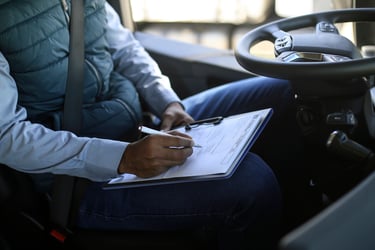Related Posts



You are about to leave Risk Strategies website and view the content of an external website.
You are leaving risk-strategies.com
By accessing this link, you will be leaving Risk Strategies website and entering a website hosted by another party. Please be advised that you will no longer be subject to, or under the protection of, the privacy and security policies of Risk Strategies website. We encourage you to read and evaluate the privacy and security policies of the site you are entering, which may be different than those of Risk Strategies.

In the world of courier and same-day delivery, it should be as clear as the road in front of you. Professional driver contracting and ongoing monitoring is critical to enhancing your safety record and minimizing costs associated with motor vehicle losses.
And at the head of the line are MVRs.
The single most valuable tool you have to identify reckless drivers before they jeopardize your insurance record is the MVR - the 'Motor Vehicle Report," a.k.a. driving record. But how useful are MVRs for screening drivers?
How do you obtain driver MVRs? In your ads, tell applicants to bring you an up-to-date MVR. Drivers can get their own at any local Motor Vehicle Office. Consider signing up with an online MVR service to gain the ability to order them yourself - the time and hassle saved will more than offset the fees. (Your insurance broker can order and review MVRs for you, too.)
While the ideal candidate has a "clean" driving record (i.e., no moving violations or at-fault accidents), the insurance and delivery industries have developed more realistic but still effective standards. Some couriers will not contract drivers with more than two or three accidents. Others accept only a certain number of "points" (note however that different states use different point systems).
In general, make sure all drivers receive a copy of your standards and understand them. If you only charge for "at-fault" accidents, remember that drivers are responsible for documenting that accidents were not their fault (for example, by producing a police report). Finally, do not let drivers on the road with suspended licenses, even if the cause is unpaid parking tickets. Have the driver pay the fines and obtain proof of license reinstatement.
When contracting drivers who will use their own vehicles - either as independent contractors or employees - two further checks are in order. The first involves vehicle inspection. Some services have extremely high standards for appearance as well as maintenance, while others merely desire "working" vehicles.
Regardless, at minimum an experienced manager should examine the vehicle's exterior, interior, and underside for such things as adequate tire tread and shocks, working windshield wipers and dashboard lights, and the absence of fluid leaks or loose exhaust pipes. It is useful to have a Vehicle Inspection Checklist to guide the manager and facilitate documentation. While many commercial checklists focus on trucks, more appropriate forms can be found.
Also, a driver's insurance is an indicator of his/her attitude toward risk and responsibility, plus respect for the law. It also is a critical line of defense against corporate liability in the event of an accident. The more insurance carried by a driver, the less likely it is that your company will get drawn into a lawsuit and must make a large insurance claim. Many delivery companies simply ask for proof of insurance - often an insurance ID card. ID cards show the name of the insurance company and the expiration date of the policy, but they do not normally show the limits of insurance carried by the driver.
Liability limits are clearly important - choose drivers with higher limits whenever possible - and should be documented on your driver spreadsheet. I recommend setting the minimum standard for liability limits at 100/300/50. These "split limits" mean that in the event of an accident the policy will pay $100,000 per person injured, $300,000 for all injuries, and $50,000 for property damage. Statistics show that such limits are usually sufficient for all but major crashes. Also, the additional premiums are reasonable - often about $200 per year.
Many delivery drivers and courier drivers carry insurance limits of 100/300/50 or higher on their own, but sometimes it can seem difficult to find qualified drivers willing to pay for anything above your state's mandatory 28 minimum insurance limits. In the past, several of the most attractive insurance programs insisted on standards of 100/300/50, but this is no longer the case. Still, companies with higher standards typically pay lower rates.
Part III of our series on hiring courier drivers will look at monitoring practices, and the critical elements of loss control for your delivery business.
Get in touch with Risk Strategies Transportation transportation@risk‐strategies.com.
The contents of this article are for general informational purposes only and Risk Strategies Company makes no representation or warranty of any kind, express or implied, regarding the accuracy or completeness of any information contained herein. Any recommendations contained herein are intended to provide insight based on currently available information for consideration and should be vetted against applicable legal and business needs before application to a specific client.


